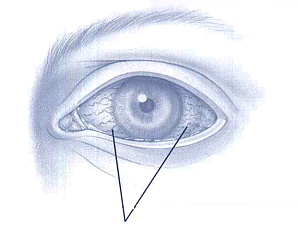“Pink eye,” the common name for conjunctivitis, is an inflammation or infection of the conjunctiva. The conjunctiva is the outer, normally clear covering of the sclera (the white part of the eye). The eye appears pink when you have conjunctivitis because the blood vessels of the conjunctiva are dilated. Pink eye is often accompanied by a discharge, but vision is usually normal and discomfort is mild.
 Inflamed Conjunctiva
Inflamed Conjunctiva
Either a bacterial or a viral infection may cause conjunctivitis. Viral conjunctivitis is much more common. It may last several weeks and is frequently accompanied by a respiratory infection (or cold). Antibiotic drops or ointments usually do not help, but symptomatic treatment such as cool compresses or over-the-counter decongestant eyedrops can be used while the infection runs it course. Unlike viral conjunctivitis, bacterial conjunctivitis can be treated with a variety of antibiotic eyedrops or ointments, which usually cure the infection in a day or two.
Conjunctivitis can be very contagious. People who have it should not share towels or pillowcases and should wash their hands frequently. They may need to stay home from school or work, and they should stay out of swimming pools.
Not all cases of conjunctivitis are caused by an infection. Allergies can cause conjunctivitis, too. Typically, people with allergic conjunctivitis have itchy eyes, especially in spring and fall. Eyedrops to control itching are used to treat allergic conjunctivitis. It is important not to use medications that contain steroids (names of steroids usually end in “-one” or “-dex”) unless prescribed by an Advanced Eye Center ophthalmologist.
Finally, not all cases of pink eye are caused by conjunctivitis. Sometimes more serious conditions, such as infections, damage to the cornea, very severe glaucoma, or inflammation inside the eye will cause the conjunctiva to become inflamed and pink. Vision is usually normal when pink eye is caused by conjunctivitis. If your vision is affected or you experience eye pain, it is recommended that you see an ophthalmologist.








